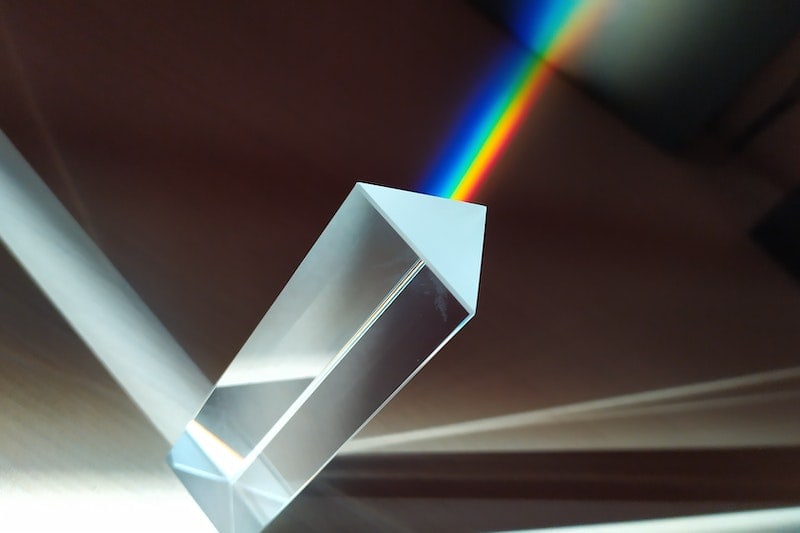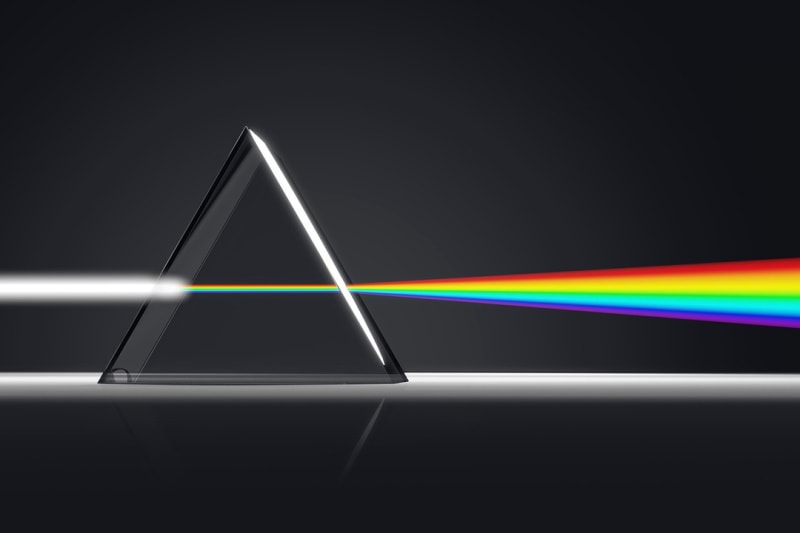What Happens When Light Goes Through a Prism?
Last Updated on

When light passes through a prism, it refracts or bends, turning into a rainbow of colors. It happens because light travels at different speeds through different materials. The amount of refraction depends on the difference in speed and the angle of incidence at which light hits the material.
When light passes through a prism, you’ll see a rainbow of colors on the other side. Since violet light has the highest frequency, it has the higher refraction.
Meanwhile, red light refracts the least due to its low frequency. So, let’s learn more about the passage of light through a prism.

What Is Refraction?
Refraction is the change in the direction of a wave due to a change in speed. It is commonly observable when waves move from one medium to another.
For example, when light waves move from air to water, they are refracted. The amount of refraction depends on the indices of refraction of the two materials. It also depends on the angle at which the waves move.
The refraction index measures how much a wave is bent when it moves from one medium to another. The higher the index of refraction, the more the wave is bent.
Refraction is responsible for many optical effects, such as the bending of light at a glass surface and the formation of images in lenses and mirrors.
Why Does a Rainbow Form When White Light Passes Through a Prism?

When shining a beam of white light through a glass prism, you will see a rainbow of colors. Each color represents a wavelength of light. For example, violet light has the shortest wavelength, and red light has the longest wavelength.
It’s the same phenomenon that forms the rainbow after the rain. When light hits a raindrop, it bends (refracts) and then splits up into different colors. In this case, the raindrops act as tiny prisms.
The visible spectrum of light forms the colors of a rainbow: red, orange, yellow, green, blue, and violet.
Isotropic materials are commonly used to make prisms. An isotropic material has the same physical properties in all directions. It means that an isotropic material will refract light equally in all directions. That’s why a prism does such a splendid job of splitting light into different colors.
Which Colors Do You See When Light Passes Through a Prism?
You see a spectrum of colors when white light passes through a prism because the different wavelengths of light bend in different amounts as they pass through the prism. The human eye can only distinguish primary colors: red, blue, and green.
All other colors of the rainbow you see are formed by mixing these three colors in different proportions because different colors correspond to different wavelengths of light. These are called secondary colors.

What Are the Types of Prisms?

All types of prisms have different properties. Plus, they alter light in different ways.
Dispersive Prisms
A dispersive prism disperses or separates light into its different colors. In other words, it takes white light and breaks it up into all of its colors. That’s why a dispersive prism is also called a rainbow maker.
- Amici Prism: It’s a compound prism present in spectrometers.
- Granite Prism: It has a long cross-section and is used for large-scale projects.
- Abbe Prism: The Abbe prism is used in periscopes and has two 90-degree angles.
Reflective Prisms
Some prisms reflect light rather than refract it. These prisms are common in single-lens reflex cameras and binoculars.
Without these reflective prisms, you’ll see things upside down through your binoculars or camera. An example of these prisms is the Abbe-Koeing prism. It has four internal reflections.
Other examples include the Dove prism, Corner-cube retroreflector, roof pentaprism, and Perger-Porro prism.
Polarizing Prisms
Polarizing prisms work on the principle of birefringence. They can split a beam of light into two beams with different polarization.
Polarizing prisms are used in many optical instruments, such as polarimeters. They can also be used to make polarized sunglasses.
- Glan–Foucault prism
- Glan–Taylor prism
- Nicol prism
- Glan–Thompson prism
- Rochon prism
- Sénarmont prism
How Does Refraction Play a Role in Dispersion?

The degree to which light is bent depends on the index of refraction. The index of refraction refers to how much a material slows down the speed of light as it passes through that material.
Air’s refractive index is 1.0003, meaning that light travels slightly slower in the air than in a vacuum. Meanwhile, water has a refraction index of 1.33. So, again, it means the light will travel slowly through the water.
How Can You Observe the Refraction of Light?
Refraction is an important property of light that allows us to see the world around us. Light waves change direction as they travel from one medium to another.
- Fill a glass with water.
- Place a pencil in the water so that it is pointing straight up.
- Look at the pencil inside the glass. The pencil will appear to be bent.
The pencil appears bent because the light waves are refracting, or changing direction, as they travel from the water to the air.
Since water has a higher refractive index than air, the light waves slow down as they enter the water. As a result, it causes the waves to bend.
You can also see refraction when you look at an object in the water. For example, when you are swimming and see the bottom of the pool, it appears closer than it actually is because the light waves are bent as they travel from the water to your eyes.

Final Thoughts
When passing through a prism, light splits into all the rainbow colors. Each color is a different wavelength of light. As a result, the different colors will bend or refract at different angles.
The angle of refraction depends on the wavelength of the light. Shorter wavelengths bend more than longer wavelengths. For example, because red light has a longer wavelength than violet light, red light bends less than violet light.
We see different colors because our eyes perceive different wavelengths of light in different ways.
Featured Image Credit: Dobromir Hristov, Pexels
About the Author Jeff Weishaupt
Jeff is a tech professional by day, writer, and amateur photographer by night. He's had the privilege of leading software teams for startups to the Fortune 100 over the past two decades. He currently works in the data privacy space. Jeff's amateur photography interests started in 2008 when he got his first DSLR camera, the Canon Rebel. Since then, he's taken tens of thousands of photos. His favorite handheld camera these days is his Google Pixel 6 XL. He loves taking photos of nature and his kids. In 2016, he bought his first drone, the Mavic Pro. Taking photos from the air is an amazing perspective, and he loves to take his drone while traveling.
Related Articles:
How to Clean a Refractor Telescope: Step-by-Step Guide
How to Clean a Telescope Eyepiece: Step-by-Step Guide
How to Clean a Rifle Scope: 8 Expert Tips
Monocular vs Telescope: Differences Explained (With Pictures)
What Is a Monocular Used For? 8 Common Functions
How to Clean a Telescope Mirror: 8 Expert Tips
Brightfield vs Phase Contrast Microscopy: The Differences Explained
SkyCamHD Drone Review: Pros, Cons, FAQ, & Verdict
